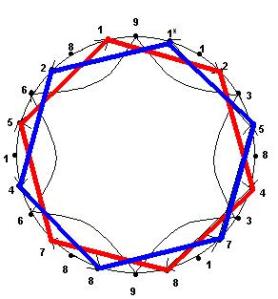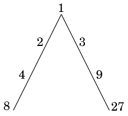This latest post is not directly connected with the material we originally intended to follow on this series of articles with.Nevertheless,we believe it makes for interesting reading and does not present as being entirely unrelated to our previous posts.
Yesterday,on the recommendation of a friend,we read through the new Dan Brown book ‘Inferno’.
Not really being fans of the authors narrative style,it took some persuasion on the friends part to get us to dip into Dan Browns latest offering.However this proved for us to be time well spent in that we did find something very unusual in there.
On the last page of his book,below the ISBN numbers and the publishers classification number,he presents the reader with a seemingly random numeric sequence.
2 4 6 8 10 9 7 5 3 1
We found this curious as it didnt seem to connect in any manner with the content of the rest his novel.
On a closer examination,we realised that not only did these numbers add to 55 – a highly significant number in itself,as we will soon see.
If we treat this numeric sequence by moving inwards from left and right to centre,we notice that there are two streams of numbers,odd and even,both converging on the number 10 which is occupying the middle position in the sequence. This odd configuration suggested something quite visual to us,like two lines of numbers converging at a central point in an upside-down ‘V’ formation-something not unlike the Greek letter ‘Lambda’.
Plato had much to say regarding this 11th letter of the Greek alphabet;
Regarding the Platonic Lambda in theTimaeus, Plato states that God created the Cosmic Soul using two mathematical strips of 1, 2, 4, 8 and 1, 3, 9, 27. These two strips follow the shape of an inverted “V” or the “Platonic Lambda” since it resembles the shape of the 11th letter of the Greek alphabet “Lambda”.
1,2,4,8-Doubling Sequence.
1,3,9,27-Tripling Sequence.
The 1,2,4,8 follows the same 1,2,4,8,7,5 patterning of the doubling circuits in our device created from the 24 reduced Fibonacci numbers.

The 1,3,9,27 tripling sequence also brings to mind the 3,6,9 vector generated by the 24 reduced Fibonacci numbers.

Plato states;
“Now God did not make the soul after the body, although we are speaking of them in this order; for having brought them together he would never have allowed that the elder should be ruled by the younger… First of all, he took away one part of the whole [1], and then he separated a second part which was double the first [2], and then he took away a third part which was half as much again as the second and three times as much as the first [3], and then he took a fourth part which was twice as much as the second [4], and a fifth part which was three times the third [9], and a sixth part which was eight times the first [8], and a seventh part which was twenty-seven times the first [27]. After this he filled up the double intervals [i.e. between 1, 2, 4, 8] and the triple [i.e. between 1, 3, 9, 27] cutting off yet other portions from the mixture and placing them in the intervals”
Timaeus (Trans;Benjamin Jowett.)
”The Platonic Lambda diagram was first attributed to Crantor of Soli (335-275 BC). It is shown in Cornford’s commentary on the Timaeus, as well as references. but not in the references of Jowett, Thomas Taylor and the other commentaries. While the even (double) series of 1, 2, 4, 8, and odd (triple) series of 1, 3, 9, 27 are cited often, none of these commentators mention the sum of the two series adds up to 55 as shown below:
The Soul of the Universe is the sum of the two series (Timaeus 35b):
Sum of the double interval series (powers of 2) = 20 + 21 + 22 + 23 = 1 + 2 + 4 + 8 = 15
Sum of the triple interval series (powers of 3) = 30 + 31 + 32 + 33 = 1 + 3 + 9 + 27 = 40
Sum of the double & triple interval series (Timaeus) = 15 + 40 = 55”
http://www.wisdomportal.com/Dante/Dante55Plato.html
55
The Number 55
The article we have linked above references an in-depth study of the significance of the number 55-the overall value of the numbers given in Dan Brown’s book.
Although Plato does not mention the relevance of the number 55, it is implicit within the two number chains given in respect of the Platonic Lambda.
1,2,4,8 -Doubling Sequence – Value =15
1,3,9,27 -Tripling Sequence -Value = 40
Total value =55
Dante’s ‘Inferno’ and the number 55.
Dante Aligheri mentions the word ‘star’, 55 times throughout the three books of his ‘Commedia’.
Might this possibly infer he was aware of Plato’s Lambda and its connection to the cosmic soul?
And if so,what other information might he have likely encoded into his work that might infer a knowledge of a ‘lost’ mathematical system?
If we count the number of lines per canto within the 3 books of Dante’s ‘Divine Comedy’-‘Inferno’,Purgatorio’ and ‘Paradiso’,and subject the result to single digit reduction,a visible pattern starts to emerge.
Click on image to enlarge.
Original version of this chart available at Peter Chou’s website;
http://www.wisdomportal.com/Dante/TotalLinesCommedia.html
( I have corrected Peter Chou’s calculation on Canto 23/’Inferno as he has given a ‘ 9’ for the reduced number of the lines whereas his 3131 should reduce to a value of 8-This was the one glaring exception within the whole calculation.) The sums rendered by reduction across the respective Cantos of Dante’s three books all fall neatly into the 1-4-7,2-5-8 and 3-6-9 patterning we note are represented within the device formed from the 24 reduced Fibonacci numbers.
This understanding is highly remarkable in that it may offer a conclusive proof that Dante Aligheri was indeed aware of this ancient mathematical knowledge and had gone to the great length of choosing to encode it into the three books of his ‘Divine Comedy’.
We see that in Canto 12,we have a 3-3-3 configuration,12 reducing to 3.
Similarily in Canto 17 we are presented with 8-8-8. 17 reducing to the number 8.
In Canto 18,we have 9-9-9. 18 reducing to the number 9.
The Cantos I have underlined in red all render sequences which contain complete permutations of 1-4-7,2-5-8 or 3-6-9.
All other Cantos across the three books give us numeric permutations which contain multiples made up of the 3 number sequences where a number is repeated within sequence.eg; 117 or 558 or 339.
A final note on the Platonic Lambda,the Lambda being the 11th letter of the Greek alphabet.
The number 11 does something quite interesting if we take two streams of numbers,1 to 11 and place them into a cross formation where the two lines meet at the number 6; we see something like this happen;
All the numbers falling into the 5 squares add up to 24.
More to follow.


